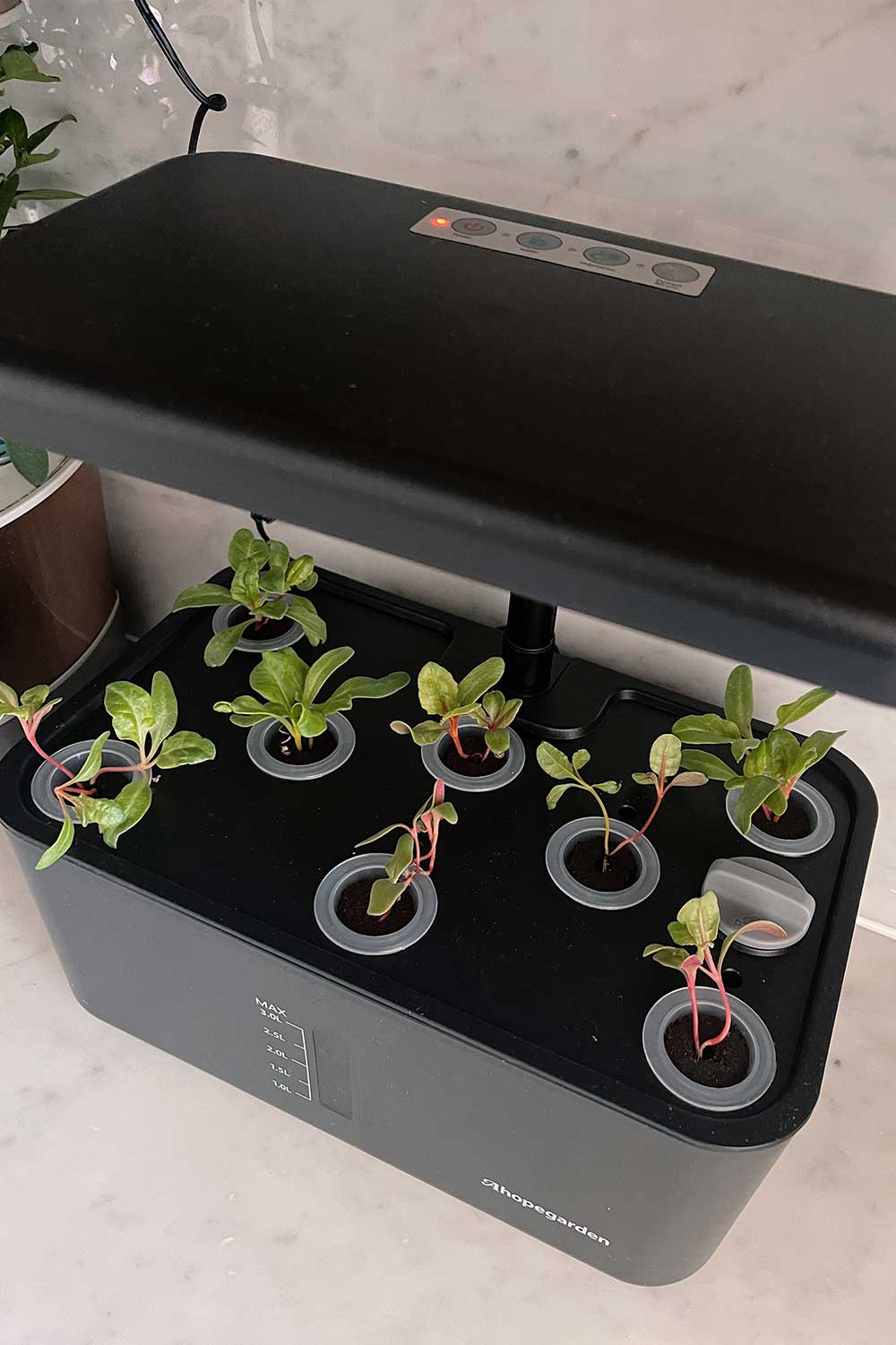Indoor hydroponic gardens are worth it due to their numerous benefits and convenience. They provide a sustainable solution for growing plants without soil, require less space and water, and allow for year-round cultivation.
Additionally, hydroponics systems promote faster plant growth and higher yields, making them a viable option for both amateur gardeners and commercial growers. Setting up and maintaining an indoor hydroponic garden may require an initial investment, but the long-term advantages far outweigh the costs.
With modern technology and advancements in hydroponics, it has become easier than ever to create and maintain a thriving indoor garden. Whether you are an urban dweller or live in an area with limited outdoor space, indoor hydroponic gardens offer a rewarding and efficient way to grow your own plants.

Credit: www.amazon.com
Advantages Of Indoor Hydroponic Gardens
Indoor hydroponic gardens are gaining popularity among both amateur and professional gardeners. With advancements in technology and growing techniques, these gardens offer several advantages that make them worth considering. Below are the key advantages:
Higher Yield
Indoor hydroponic gardens yield significantly higher crop production compared to traditional soil-based gardens. The hydroponic system allows plants to receive an optimal balance of water, nutrients, and oxygen, promoting faster and healthier growth. With the right environmental conditions, plants can grow up to 25% faster and produce up to 30% higher yields than traditional gardening methods.
Year-round Growing
One of the greatest advantages of indoor hydroponic gardens is the ability to grow plants throughout the year, regardless of the external conditions. By controlling the lighting and temperature in a controlled indoor environment, it’s possible to create the perfect growing conditions for plants. This means you can enjoy fresh, homegrown produce even during the winter months when outdoor gardening is not feasible.
Controlled Environment
With an indoor hydroponic garden, you have full control over the growing environment. This control allows you to optimize factors such as lighting, temperature, humidity, and nutrient levels to meet the specific requirements of different crops. By eliminating the reliance on unpredictable weather patterns and soil quality, you can create an ideal environment for plants to thrive. It also reduces the risk of pests and diseases that can damage or destroy crops, leading to healthier and more consistent harvests.

Credit: shershegrows.com
Potential Challenges Of Indoor Hydroponic Gardens
While indoor hydroponic gardens offer numerous benefits, there are also some potential challenges that enthusiasts may encounter. It’s essential to weigh these challenges against the advantages to determine if indoor hydroponic gardens are worth it for your specific needs. Below are some of the key challenges you might face when delving into indoor hydroponic gardening.
Initial Investment
- High startup cost incl the setup, nutrient solution, and lighting
- Quality equipment essential for optimal growth
- Operating costs like electricity for lighting & pump
Maintenance
- Regulated water pH & nutrient levels are crucial
- Sufficient lighting and airflow maintenance
- Regular checking for pests or disease
- Continuous monitoring of plant health
Technical Knowledge
- Understanding of proper nutrient balance
- Knowledge of hydroponic system operation
- Ability to troubleshoot issues effectively
Factors To Consider Before Starting An Indoor Hydroponic Garden
Consider these factors before starting an indoor hydroponic garden to determine if it is worth your time. Assess the available space, budget, level of commitment, and desired plant variety to ensure a successful and fulfilling experience.
Factors to Consider Before Starting an Indoor Hydroponic Garden Creating an indoor hydroponic garden is an exciting prospect for many gardening enthusiasts. Not only does it offer the convenience of gardening indoors, but it also allows you to grow plants without the need for soil. Before you dive into this innovative gardening method, let’s delve into a few key factors that you should consider. These factors include space availability, budget, and time commitment.Space Availability
One crucial factor to consider before embarking on your indoor hydroponic gardening journey is the availability of space. Unlike traditional gardens that require vast outdoor areas, indoor hydroponic gardens enable you to grow plants in a controlled environment. However, you’ll still need to make sure you have enough room for your garden setup. If you have limited space, don’t fret! Indoor hydroponic gardens can be adapted to fit even the tiniest of apartments. Vertical gardening systems and compact herb gardens are great options for maximizing space. Assess your available area and consider how much of it you can allocate for your indoor garden.Budget
Another factor to consider is your budget. Indoor hydroponic gardens can vary significantly in cost depending on the complexity and scale of your setup. It’s important to determine a budget that suits your financial situation before diving in. Consider the costs of essential components such as growing lights, nutrient solutions, pH meters, and growing media. These items contribute to the overall cost of setting up and maintaining your indoor hydroponic garden. Additionally, factor in the ongoing cost of electricity to power the grow lights and maintain the ideal growing environment.Time Commitment
Gardening, in any form, requires a certain amount of time commitment, and an indoor hydroponic garden is no exception. Although hydroponic systems can reduce the time spent on tasks like weeding and watering, they still require some dedication. It’s important to determine how much time you can allocate to maintaining your indoor hydroponic garden. Some plants may require more attention than others, especially when it comes to monitoring nutrient levels, pH balance, and temperature. Assess your schedule and ensure you have enough time to regularly check and maintain your hydroponic garden. In conclusion, before starting an indoor hydroponic garden, consider the factors of space availability, budget, and time commitment. Assess your available space, determine a suitable budget, and ensure you can allocate enough time to care for your plants. By thoroughly considering these factors, you’ll set yourself on a path to success in your indoor hydroponic gardening venture.| Factors to Consider Before Starting an Indoor Hydroponic Garden |
|---|
Space Availability |
Budget |
Time Commitment |
Common Types Of Plants For Indoor Hydroponic Gardens
When it comes to indoor hydroponic gardening, there is a wide variety of plants that thrive in this soil-less system. Whether you have limited outdoor space or simply want to grow fresh produce all year round, the convenience and efficiency of hydroponic gardening make it an attractive option. In this article, we will explore three common types of plants suitable for indoor hydroponic gardens: leafy greens, herbs, and tomatoes.
Leafy Greens
Leafy greens, such as lettuce, spinach, and kale, are excellent choices for indoor hydroponic gardens. These nutrient-rich vegetables grow quickly and can be harvested multiple times, making them a popular choice among hydroponic gardeners.
One of the main advantages of growing leafy greens hydroponically is that you can control their exposure to light and nutrients, ensuring optimal growth conditions. This control allows you to produce consistently tender and flavorful greens year-round.
Here are a few examples of leafy greens that thrive in indoor hydroponic systems:
- Butterhead lettuce
- Bibb lettuce
- Swiss chard
- Mizuna
- Arugula
Herbs
Herbs are another popular choice for indoor hydroponic gardens, thanks to their compact size and aromatic foliage. With hydroponics, you can grow a wide range of herbs, from traditional favorites like basil and parsley to more exotic varieties like cilantro and rosemary.
Growing herbs hydroponically not only allows you to enjoy fresh flavors and aromas year-round but also ensures a steady supply of these culinary essentials at your fingertips. Plus, you can experiment with different herb varieties and even create custom herb blends to enhance your favorite dishes.
Here are some herb options for your indoor hydroponic garden:
- Basil
- Mint
- Parsley
- Dill
- Chives
Tomatoes
Tomatoes are a favorite plant for many gardeners, and they also happen to be well-suited for indoor hydroponic gardens. Not only do these juicy fruits thrive in hydroponic systems, but they also offer a bountiful harvest throughout the year.
Indoor hydroponic tomato plants tend to be healthier, as they are less prone to soil-borne diseases. Moreover, the controlled environment allows for optimized growing conditions, resulting in faster growth and higher yields.
Here are a few types of tomatoes that you can grow hydroponically:
| Tomato Variety | Description |
|---|---|
| Cherry tomatoes | Small, bite-sized tomatoes that are sweet and perfect for snacking or adding to salads. |
| Beefsteak tomatoes | Large, meaty tomatoes that are ideal for slicing and using in sandwiches or sauces. |
| Heirloom tomatoes | Colorful and flavorful tomatoes that come in a variety of shapes and sizes. |
With these common types of plants, you can create a diverse and thriving indoor hydroponic garden. Whether you’re craving fresh salads, aromatic herbs, or juicy tomatoes, the possibilities are endless when it comes to indoor hydroponic gardening.
Tips For Successful Indoor Hydroponic Gardening
When it comes to successful indoor hydroponic gardening, certain tips can make a significant difference. From maintaining proper nutrient balance to monitoring pH levels, there are essential factors to consider for ensuring the success of your indoor hydroponic garden.
Proper Nutrient Balance
Maintaining proper nutrient balance is crucial for the health and vitality of your hydroponic plants. It’s essential to ensure that the nutrient solution contains the necessary macronutrients such as nitrogen, phosphorus, and potassium, as well as micronutrients like iron, manganese, and copper. Using a quality hydroponic nutrient solution that provides the correct balance of these essential elements is essential for the growth and development of your plants.
Lighting Considerations
Lighting is one of the most critical factors for the success of an indoor hydroponic garden. Ensuring that your plants receive the appropriate light intensity and spectrum is essential for healthy growth. LED grow lights are a popular choice for indoor hydroponic gardens due to their energy efficiency and ability to provide the optimal light spectrum for plant growth. Positioning the lights at the right distance from the plants and adjusting the light cycle according to the plant’s needs is essential for maximizing growth and yield.
Ph Monitoring
Monitoring pH levels is essential in hydroponic gardening as it directly affects nutrient availability to the plants. Maintaining the correct pH range for your hydroponic system is crucial for nutrient uptake and overall plant health. Utilizing a quality pH meter and buffer solutions, regularly checking and adjusting the pH of your nutrient solution is vital for preventing nutrient deficiencies and ensuring optimal plant growth.

Credit: techcrunch.com
Conclusion
Indoor hydroponic gardens offer a convenient and efficient way to grow fresh produce at home. While there are initial costs, the long-term benefits of year-round harvests and sustainability make it worth the investment. With proper care and maintenance, hydroponic gardens can provide a steady supply of healthy, home-grown vegetables and herbs.








